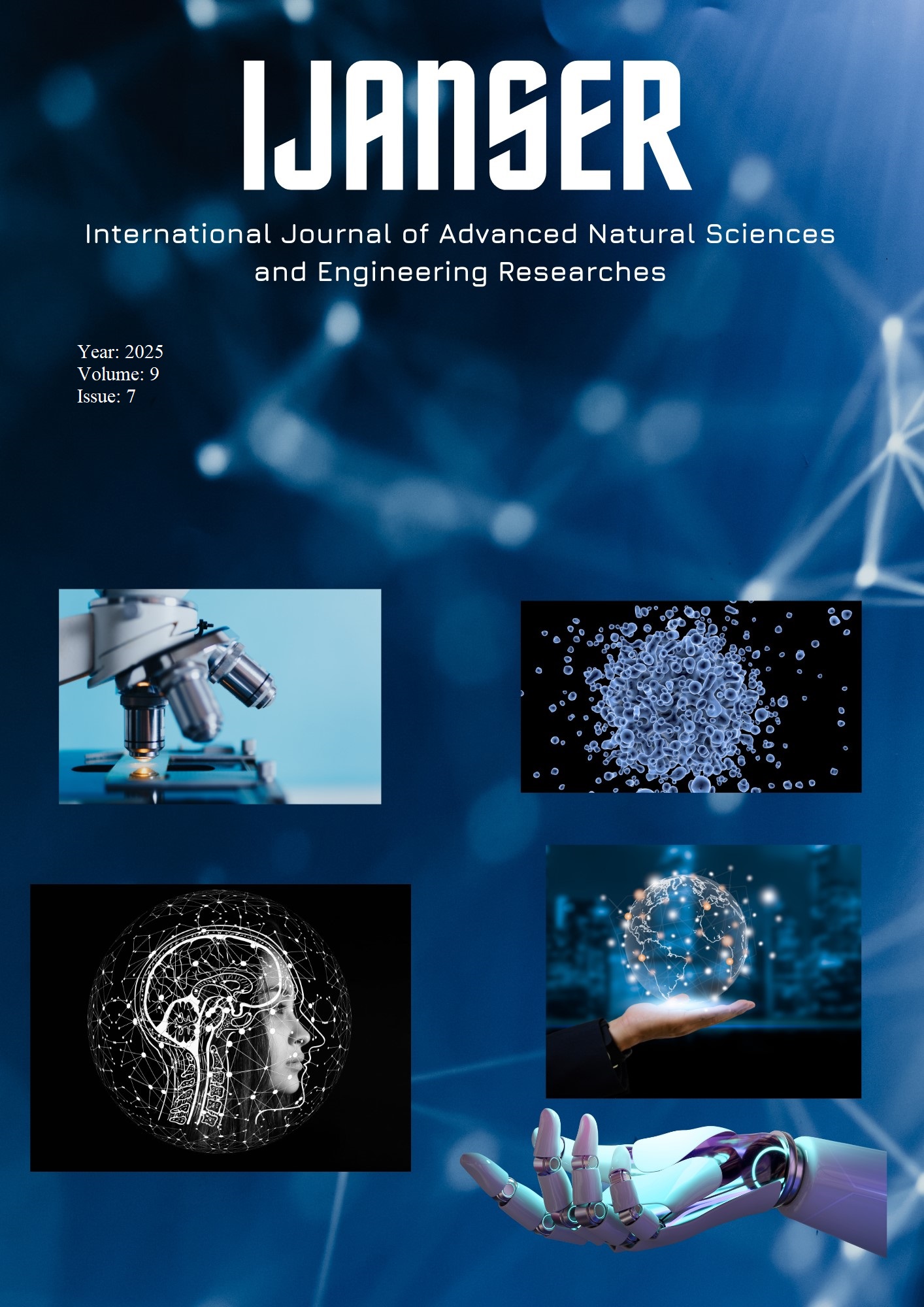Gene Expression of the MLH1 gene is regulated by non-coding RNA in patients with lung cancer
Keywords:
Lung Cancer, Gene Expression, Non-Coding RNA Genes, MLH1 Gene, MMR System, Snorna-21 And FOXD2-AS1, Qrt-PCRAbstract
Lung cancer is a common cancer worldwide and can occur due to various causes, one of which is
the MMR mismatch repair system. This system repairs mismatched nucleotides in the DNA strand during
replication. MLH1, a key gene in the MMR system, is essential in repairing mutations in lung cancer
patients. Certain non-coding RNA genes, such as snoRNA and FOXD2-AS1, can regulate the expression of
this gene. These non-coding RNAs influence MLH1 gene expression in lung cancer patients. The
examination targeted at detecting the impact of miRNA and non-coding RNA on MLH1 gene expression
rates in lung cancer patients situated within Dohuk City. The study included 70 patients aged between 45 and
65 from September to October 2024, referred to AZADI Hospital. The sample was divided into two groups:
one included 55 lung cancer patients, another group included 15 individuals and was considered the control
group. A total of 5 ml of blood was drawn from each patient and segmented into two parts. The first part was
put in EDTA for DNA extraction, while the second part was placed in a Trizol tube for mRNA and non
coding RNA extraction. The study consisted of two stages: first, detecting the level of MLH1 gene
expression; second, assessing the level of non-coding RNA influencing gene activity. The results showed that
the MLH1 gene expression value was 0.38, while the gene expression values for non-coding RNAs were 4.4
for snoRNA and 4.2 for FOXD2-AS1.
Downloads
References
Yüksel, C. (2023). Does cell type in lung cancer have any clinical importance? European Journal of Therapeutics, 24(S1), S4–S10. https://doi.org/10.5152/EurJTher.2018.1002
de Groot, P. M., Chung, J. H., Walker, C. M., Yom, S. S., Kanne, J. P., et al. (2019). ACR Appropriateness Criteria® Noninvasive Clinical Staging of Primary Lung Cancer. Journal of the American College of Radiology, 16(5), S184–S195. https://doi.org/10.1016/j.jacr.2019.02.021
Ramón y Cajal, S., Sesé, M., Capdevila, C., Aasen, T., De Mattos-Arruda, L., Diaz-Cano, S. J., Hernández-Losa, J., & Castellví, J. (2020). Clinical implications of intratumor heterogeneity: Challenges and opportunities. Journal of Molecular Medicine, 98(1), 161–177. https://doi.org/10.1007/s00109-020-01892-2
Cooper, W. A., Lam, D. C., O’Toole, S. A., & Minna, J. D. (2013). Molecular biology of lung cancer. Journal of Thoracic Disease, 5(Suppl 5), S479–S490
Larsen, J. E., and Minna, J. D. (2011). Molecular biology of lung cancer: Clinical implications. Clinics in Chest Medicine, 32(4), 703–740. https://doi.org/10.1016/j.ccm.2011.08.005
Cagle, P. T., Allen, T. C., & Olsen, R. J. (2013). Lung cancer biomarkers: present status and future developments. Archives of Pathology & Laboratory Medicine, 137(9), 1191-1198
Lindeman, N. I., Cagle, P. T., & Beasley, M. B. (2013). Molecular testing guideline for selection of lung cancer patients for EGFR and ALK tyrosine kinase inhibitors. Journal of Molecular Diagnostics, 15(4), 415-453.
Siegel, R. L., Miller, K. D., & Jemal, A. (2017). Cancer statistics, 2017. CA: A Cancer Journal for Clinicians, 67, 7–30. https://doi.org/10.3322/caac.21387
Andersen, S. D., Liberti, S. E., & Lutzen, A. (2012). Functional characterization of MLH1 missense variants identified in Lynch syndrome patients. Human Mutation, 33(12), 1647-1655. https://doi.org/10.1002/humu.22153
Ganot, P., Caizergues-Ferrer, M., and Kiss, T. (1997). The family of box ACA small nucleolar RNAs is defined by an evolutionarily conserved secondary structure and ubiquitous sequence elements essential for RNA accumulation. Genes & Development, 11(7), 941–956. https://doi.org/10.1101/gad.11.7.941
Bouchard-Bourelle, P., Desjardins-Henri, C., & Mathurin-St-Pierre, D. (2020). snoDB: An interactive database of human snoRNA sequences, abundance, and interactions. Nucleic Acids Research, 48, D220-D225
Shi, X., Sun, M., Liu, H., Yao, Y., & Song, Y. (2013). Long non-coding RNAs: A new frontier in the study of human diseases. Cancer Letters, 339(2), 159-166. https://doi.org/10.1016/j.canlet.2013.07.014
Ren, W., Zhu, Z., & Wu, L. (2019). FOXD2-AS1 correlates with the malignant status and regulates cell proliferation, migration, and invasion in cutaneous melanoma. Journal of Cell Biochemistry, 120(10), 5417-5423. https://doi.org/10.1002/jcb.27864
Hu, Q., Tai, S., & Wang, J. (2019). Oncogenicity of lncRNA FOXD2-AS1 and its molecular mechanisms in human cancers. Pathology Research and Practice, 215, 843-848. https://doi.org/10.1016/j.prp.2019.04.018
Chen, G., Sun, W., Hua, X., Zeng, W., & Yang, L. (2018). Long non-coding RNA FOXD2-AS1 aggravates nasopharyngeal carcinoma carcinogenesis by modulating miR-363-5p/S100A1 pathway. Gene, 645, 76-84. https://doi.org/10.1016/j.gene.2017.11.060
Zhu, Y., Qiao, L., Zhou, Y., Ma, N., Wang, C., & Zhou, J. (2018). Long non-coding RNA FOXD2-AS1 contributes to colorectal cancer proliferation through its interaction with microRNA-185-5p. Cancer Science, 109(5), 1545-1556. https://doi.org/10.1111/cas.13632
Hu, Q., Tai, S., & Wang, J. (2019). Oncogenicity of lncRNA FOXD2-AS1 and its molecular mechanisms in human cancers. Pathology Research and Practice, 215, 843-848. https://doi.org/10.1016/j.prp.2019.04.018
Ayuk, S. M., Abrahamse, H., & Houreld, N. N. (2016). Photobiomodulation effects on gene expression of cell adhesion molecules in diabetic fibroblasts. Journal of Photochemistry and Photobiology B: Biology, 161, 368-374.
Herman, J. G., Umar, A., & Polyak, K. (1998). hMLH1 promoter hypermethylation incidence and functional consequences in colorectal carcinoma. Proceedings of the National Academy of Sciences, 95(12), 6870-6875
Henras, A. K., Dez, C., & Henry, Y. (2004). H/ACA and C/D snoRNP structure-function dynamics in RNA research. Current Opinion in Structural Biology, 14(3), 335-343.
Roa, J. C., Anabalon, L., & Roa, I. (2006). Promoter methylation profile in gallbladder cancer. Journal of Gastroenterology, 41, 269-275.





